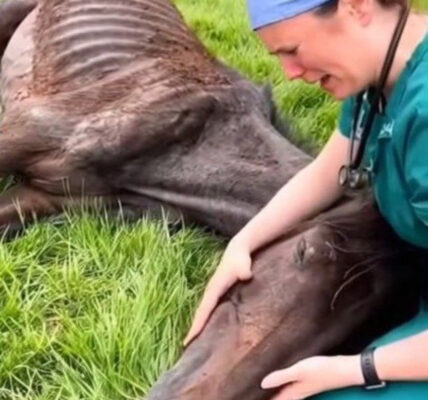It is one of nature’s most humbling sights — the moment an elephant falls asleep.

For creatures so vast, so powerful, and so commanding in presence, the act of closing their eyes and surrendering to rest transforms them into something entirely different: peaceful, gentle, almost fragile. Their great bodies, which can shake the earth when they walk, suddenly seem weightless against the quiet rhythm of sleep.
As dusk settles over the savanna, the herd begins to slow. The calves, always restless and curious, nudge at their mothers’ legs before finally curling up against their sides. The older elephants stand close, forming a loose circle of safety.
Their trunks rest against one another or gently brush the ground, and their eyes — small compared to the vastness of their frame — begin to close.
For a few minutes, there is movement — a shuffle, a deep exhale, a soft rumble that vibrates through the earth. Then stillness.

To watch an elephant sleep is to watch trust in its purest form. These giants, who live their lives in constant awareness of danger, who protect their young with fierce devotion, only let their guard down when they feel completely safe — usually among their own.
Some lie down fully, their legs folding beneath them with surprising grace. Others sleep standing, their immense bodies swaying gently, trunks curled inward as though cradling invisible dreams.
Their breathing becomes slow and rhythmic, a sound that seems to echo the heartbeat of the world itself.
It’s easy to forget that even elephants — beings of immense strength and wisdom — need rest. But when they sleep, they remind us that power and peace can coexist. Their slumber reveals a softness that lies beneath their strength, a vulnerability that mirrors our own.
Scientists have observed that elephants, like humans, dream. They experience rapid eye movement, twitching trunks, and subtle muscle spasms as their minds wander through the deep recesses of memory and imagination.

What do they dream of, we wonder? Of rain after drought? Of their young splashing in muddy pools? Of the low, familiar rumbles of their herd calling across the plains?
Perhaps, in those moments, they dream of peace — the same peace their presence brings to anyone who watches them.
What makes this ritual even more remarkable is how communal it is. Elephants rarely sleep alone. Their herd becomes their home, their sanctuary. The young lean into the warmth of the elders. The mothers stand guard, while the older bulls linger nearby, forming a living shield. It is a choreography of connection — each elephant’s position chosen with quiet intention, ensuring every member feels safe.
In their togetherness, they embody something deeply human — the need to rest not only for ourselves, but beside those we trust, knowing that someone will keep watch while we dream.

As the night deepens, the stars rise above the acacia trees, painting silver light across their gray backs. The air hums with the quiet pulse of insects, the distant cry of a night bird, and the slow, steady breathing of sleeping elephants. The sight is almost spiritual — as if the earth itself has exhaled, content to rest for a while.
When dawn breaks, the first rays of sunlight spill across the horizon, and the herd stirs again. The calves rise first, their small trumpets echoing through the cool air. Mothers stretch their trunks, brushing them over their young as if to say, I’m here.
The older elephants shake off the dust, eyes soft and calm. Their rest has ended, but the peace lingers.
To see an elephant sleep is to glimpse the soul of nature — raw yet tender, powerful yet profoundly gentle. It’s a reminder that no matter how strong we are, every living being needs moments of stillness to heal, to dream, to remember what it means to be alive.
Because in their slumber, these giants teach us something sacred: that rest is not surrender, but restoration — the silent heartbeat of life continuing on, one peaceful breath at a time.




